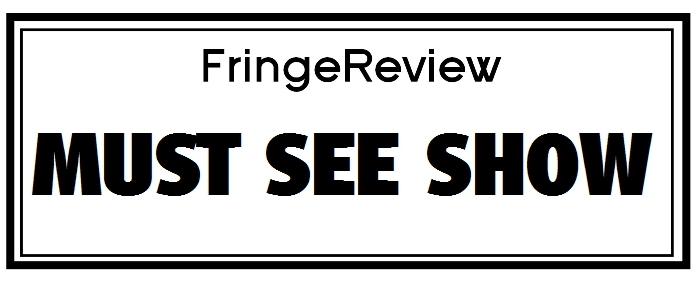FringeReview UK 2017
Wings
Young Vic

Genre: Aerial Theatre, Drama, Multimedia, Physical Theatre, Short Plays, Theatre
Venue: Young Vic
Festival: FringeReview UK
Low Down
Natalie Abrahami’s challenge is still to prove how successfully Kopit’s play transposes from radio. Michael Levine’s transparent panels flank a flying thrust that like them slides away whilst Juliet Stevenson’s character aviator, as Guy Hoare’s nocturnal lighting stabs or caresses. The panels sometimes project Will Duke’s cloud projections, to the occasional crash of Gareth Fry’s sound design. Till November 4th.
Review
If the Flying Becketts instantly comes to mind in this extraordinary production of Arthur Kopit’s 1978 Wings, adapted from his 1976 radio play, it’s for all the right reasons.
Juliet Stevenson’s not so much front and central as anywhere but. Poised somewhere between her last appearance at the Young Vic in Happy Days – Stevenson heavily grounded up to her neck in sand – and inevitably Peter Pan, here she’s immobilised everywhere she flies, imprisoned far more than Winnie with her vectors of sand and invisibility. Natalie Abrahami’s challenge is still to prove how successfully Kopit’s play transposes from radio, and how it flies from any clinical gravitation of someone suffering a stroke.
Michael Levine’s transparent panels flank a flying thrust that like them slides away whilst Stevenson’s character aviator (the term used here, aviatrix, ought to go the way of actress) suspends disbelief in her incarnation as an ancient silvery weather balloon, skydiver which at one point she is, as Guy Hoare’s nocturnal lighting stabs or caresses like a benign searchlight. There’s projections of Stilson’s wing-walking past on a World War One Curtiss Jenny: Stilson’s profession was quintessentially 1930s, but bar this the feel’s timeless. Emily Stilson gyrates somersaults and agonizes between lights and transparencies. The panels sometimes project Will Duke’s cloud projections, occasionally a vertical nose-dive horizontally presented, or stars. Much of the time the panels absent themselves particularly latterly. They’re the clouds of unknowing painfully rolled back. The combination’s not only bewitching, it grounds a vision daring a tissue-fine avatar of loss, aphasia, of bits of the brain blanked to the occasional crash of Gareth Fry’s sound design. It couldn’t be imagined better.
Stevenson has first to come in and land, to realize the extent of her absence. The first sequence not only navigates quite literally her hallucinatory flight, it revs a full vision of her past, profiles the way her mind has worked before the inevitable crash-landing.
One metaphor is never to allow Stevenson to enjoy feet on the ground. Even when she touches down it’s a balletic toe-touch dragged away by the harness she works with throughout. Work Stevenson does, with immense balletic verve, never allowing this to distract from her persona even as she swoops away like a blown sweet wrapper, a bit of far skywriting or inevitably a flying scarf. To repeated laments of ‘They’ve got me’ she persuades us ‘Mrs Stilson’ is literally above the heads of medical attendants snatching at and swinging her into a mimed bed (she’s still suspended horizontally); and naturally below their speech horizons: she can hear but not make out words. When she does make out ‘Washington’ as an answer for instance we can hear it, the doctors can’t. She attempts this, and it’s not certain if that croak’s even registered.
We’re seeing this then from Stilson’s stroke-skewed angle, but not always. There’s about ten minutes of visceral reaction to unctuous doctors, a particularly infantilising nurse who gets spat out as it were trying to feed the tetchy flyer, and as she grasps at the name-tag in a bouquet and finally failing bats it away all the force of pent despair flings out centripetally in it.
The redemptive twist’s through the prism of Stilson’s actual words as heard by one doctor: ’that’s the twither of it’ and a spill of neologisms, collided words with spells of sense and wrenched syntax artfully fly nearer the ground of mutual intelligibility. Stilson’s efforts with a toothbrush are painfully real, Stevenson pushing out any glutinous failure with throbbing concentration. It’s the compete refraction of a stroke, struggling up to words.
It’s Lorna Brown’s Amy who pushes the play from its airborne metaphor to such redemptive observation. Brown’s empathic role doesn’t disguise her glowingly conveying what the poet James Kirkup referred to as a correct compassion. What animates this is the socialisation of a previously individual vision. Therapy sessions throw up characters like Kelle Bryan’s affable Billy, whose speech is only slightly impaired after tumour removal; Kopit’s clinically insistent on this and it works, as does Mary Sheen’s more volatile Mrs Timmins. There’s fine supportive work too from David Emmings, Nicholas Gasson, Emily Wachter, Richard James-Neale and Emily Mytton. The whole production moves closer to the ground, except that Stevenson’s feet still drag slightly off it.
There’s quietly magical scenes to come, twists worth craning your neck for. It’s an extraordinary play, and though it provides only glints and sidelights into who Emily Stilson is, was or might just become, that’s its point. The very struggle for identity allows only slivers of what we conceive of as rounded; it’s unnervingly partial. Stevenson’s performance mesmerises, appals, thrills and re-asserts her unique straddling of classic and unquiet modernist in a few dizzying months. There’s no doubt Wings proves its life in the theatre here. It breaks new air.


















































